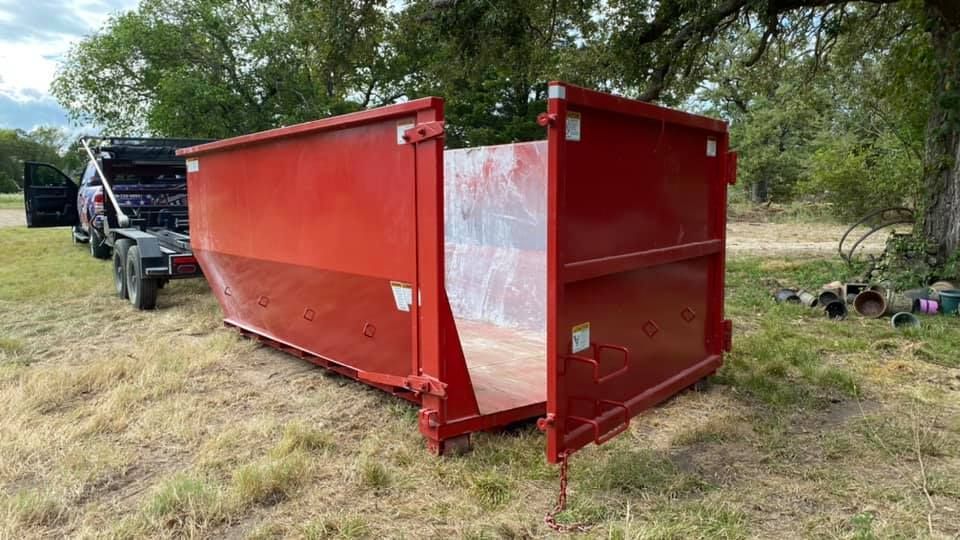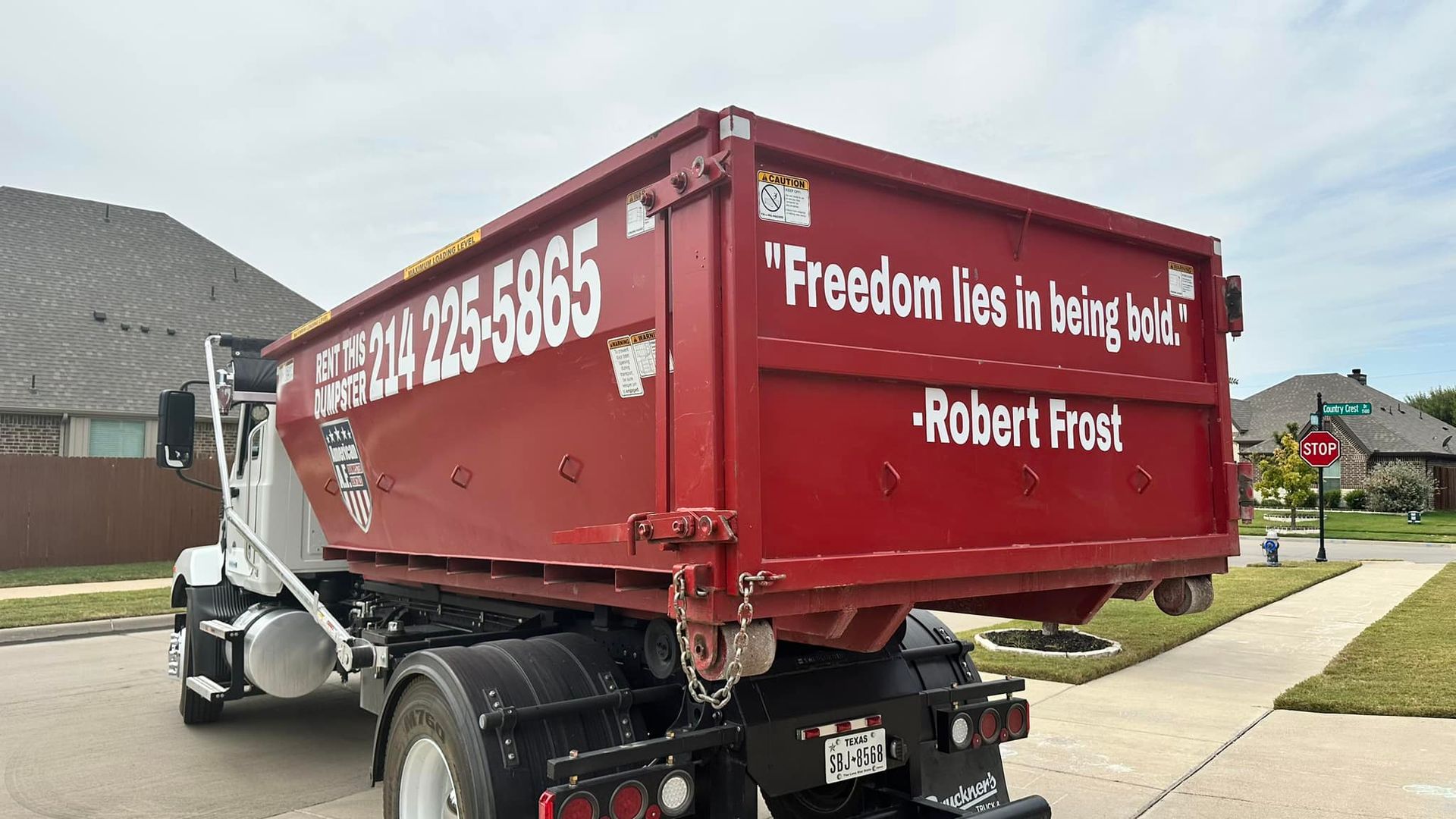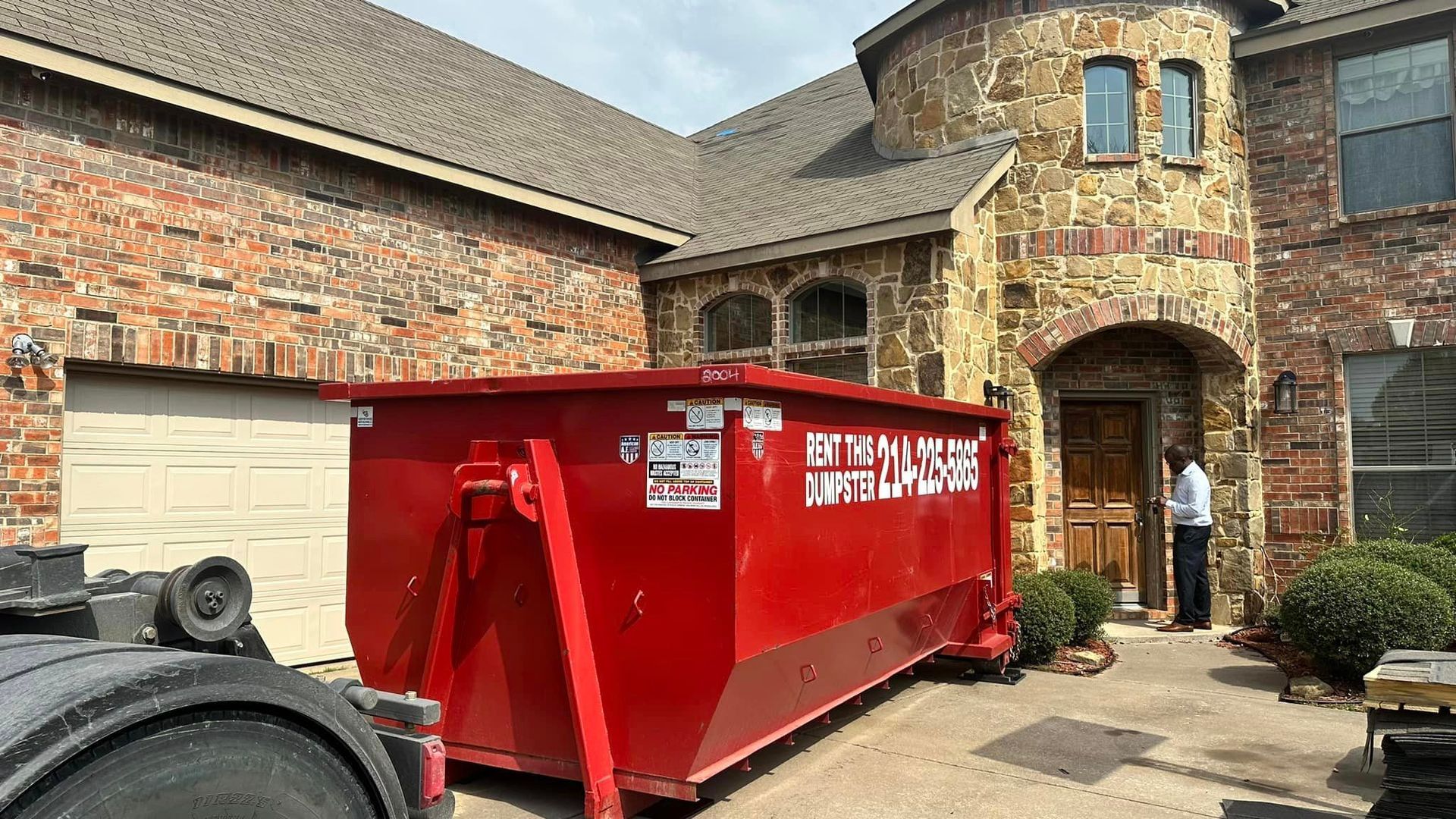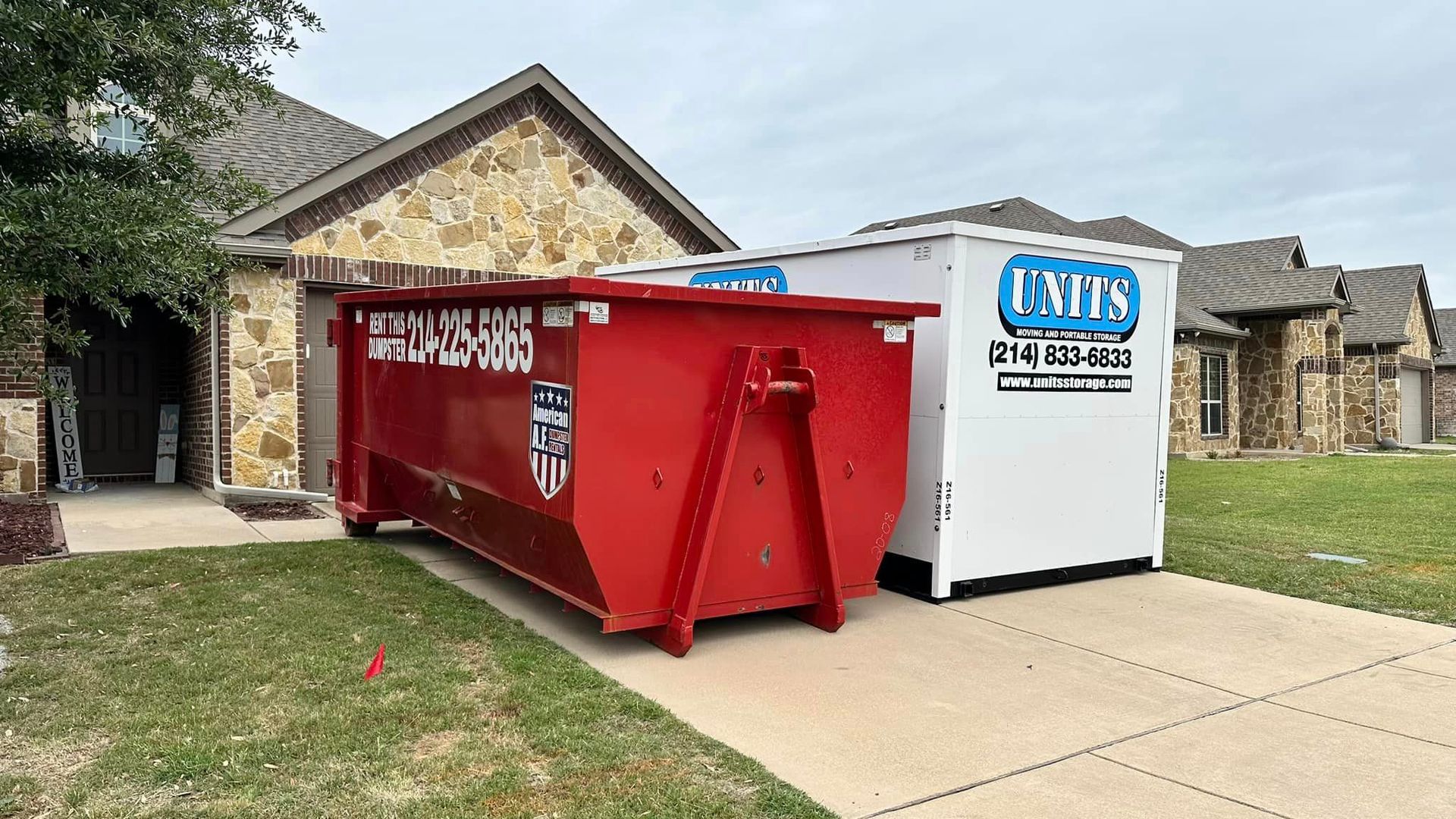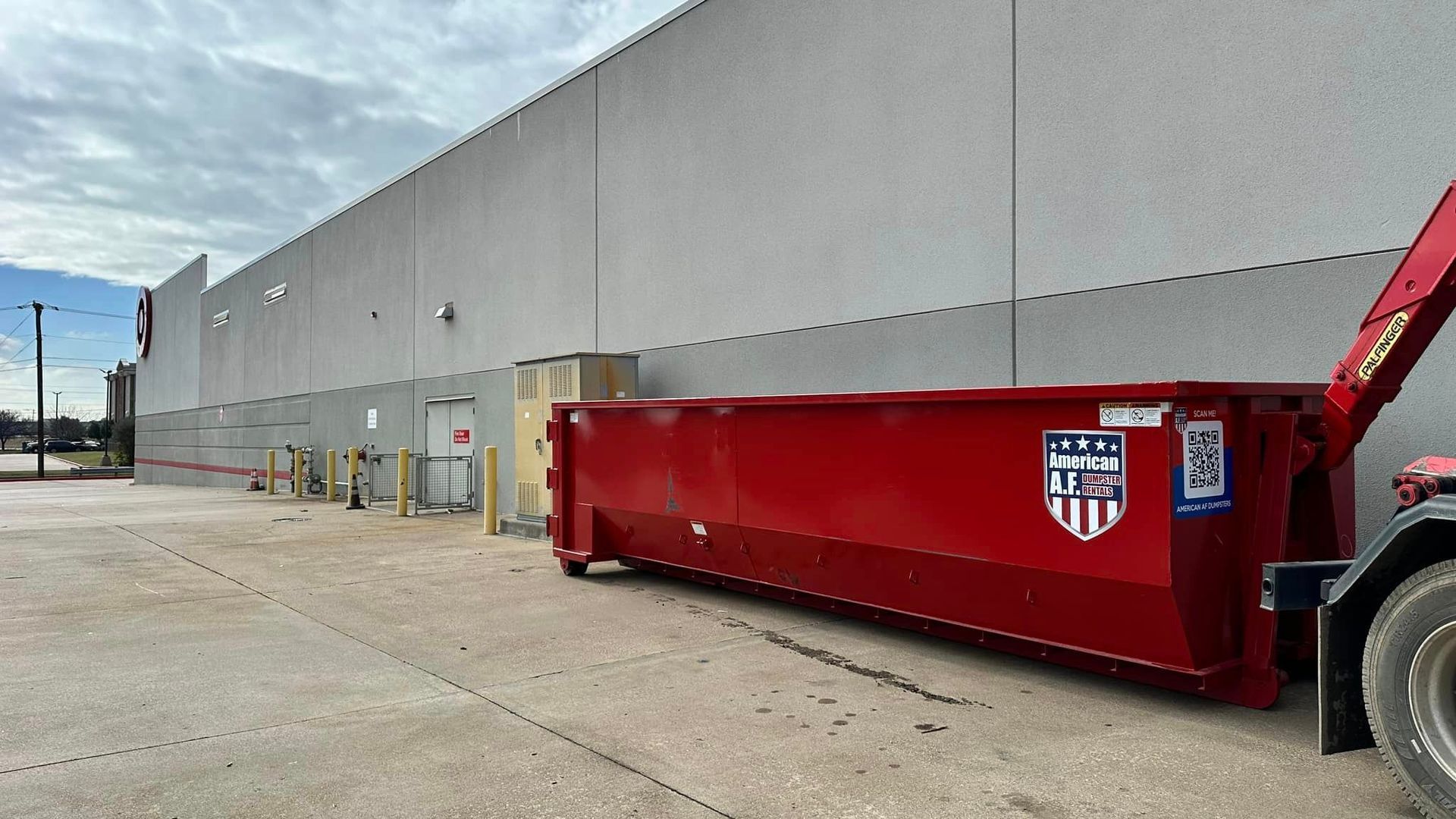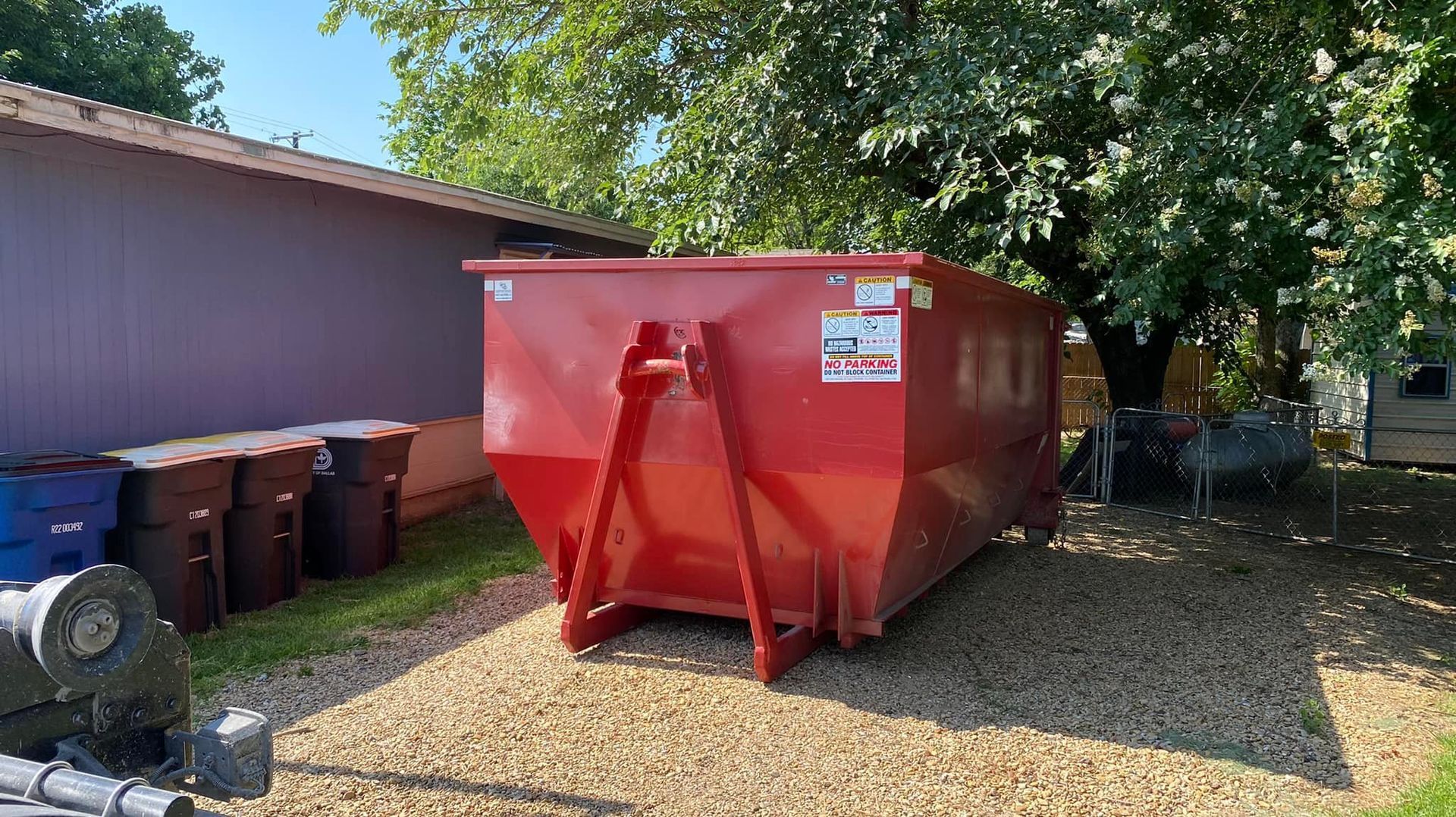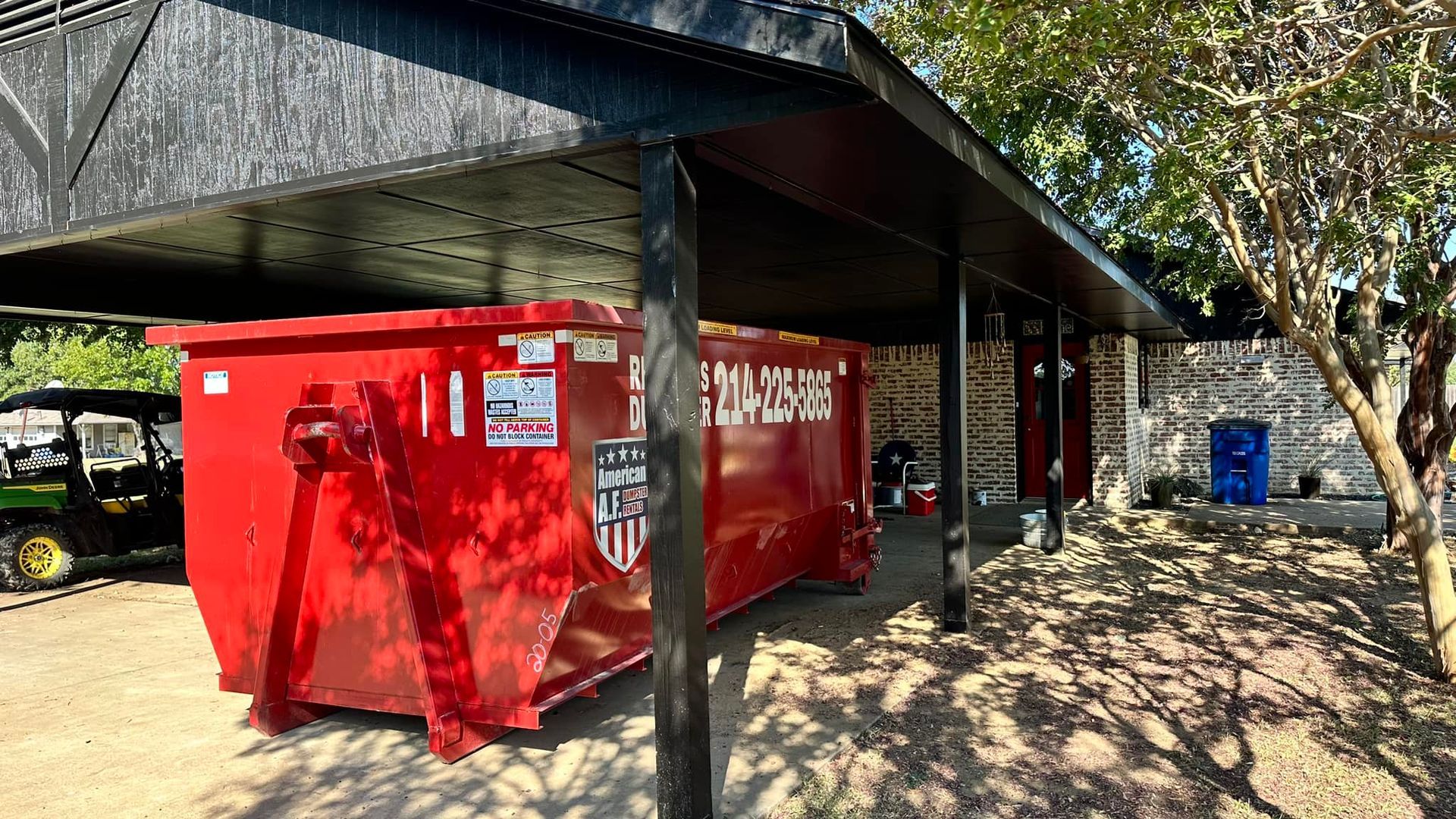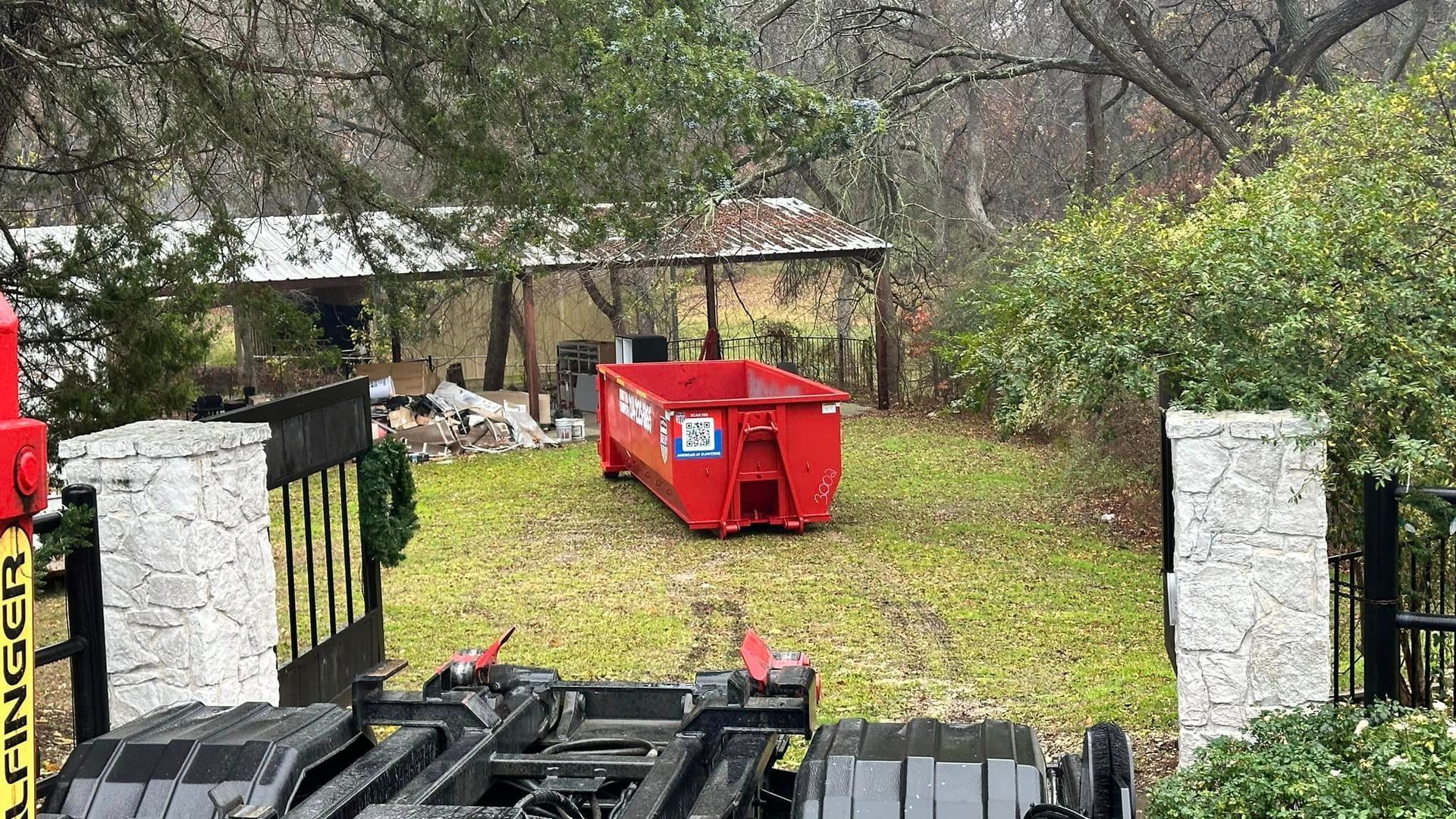What Can You Put in a Dumpster Rental in 2024?
What Can You Put in a Dumpster Rental?
What you can put in a dumpster rental typically includes household trash, wooden furniture, non-hazardous household appliances, yard waste, clean dirt, electronics (excluding those with lithium batteries), alkaline batteries, empty aerosol cans, demolition debris, as well as brick, asphalt, concrete, construction debris, lumber, storm debris, and shingles.
Avoid making a costly mistake by reading this amazing breakdown of what you can put in a dumpster rental by American AF Dumpsters!
What You CAN Throw Away
Household Trash
Household trash, including kitchen waste and similar non-organic trash, is a staple of dumpster contents. However, it's crucial to avoid hazardous waste items.
Disposal of household trash in dumpsters is common and convenient, offering an efficient way to manage everyday waste. However, excluding hazardous items ensures environmental safety and compliance with local regulations.
Wooden Furniture
Wooden furniture is typically accepted, but check with your dumpster rental company for specific types of furniture they accept.
Dumping wooden furniture is a practical solution for disposing of unwanted items, especially during large cleanouts or renovations. However, some types of treated wood may require special handling due to potential toxins.
Household Appliances
Old appliances like microwaves and toasters can go in a rented dumpster. However, appliances like AC units and refrigerators, especially those in older homes, may contain hazardous fluids or freon-containing appliances and are not allowed.
Most household appliances are safe for dumpsters, aiding in easy disposal during home cleanouts. Restrictions on certain appliances protect against the release of harmful substances into the environment.
Yard Waste
Green waste like tree limbs and grass clippings is acceptable. For heavy debris like stumps, check with your dumpster company for any additional fees.
Yard waste disposal in dumpsters is a convenient way to handle garden clean-up. However, fees for heavy materials like stumps help cover the extra costs incurred by the waste management service.
Dirt
Clean dirt is usually permissible, but be mindful of weight limits, as it's considered heavy materials.
Dumping clean dirt is often necessary during landscaping projects. Adhering to weight limits ensures safety and prevents overloading of the dumpster.
Electronics
Electronic devices and cell phones can be disposed of, but lithium batteries must be removed due to their hazardous nature.
Electronics are commonly discarded, but proper disposal is crucial to prevent toxic materials from harming the environment. Removing lithium batteries helps in recycling them responsibly.
Alkaline Batteries
Standard alkaline and dry-cell batteries are usually safe, but check local regulations for disposal guidelines.
Alkaline batteries are generally non-hazardous, making them suitable for regular disposal. However, local guidelines ensure proper handling to avoid environmental impact.
Empty Aerosol Cans
Aerosol cans can be thrown away if empty. Full or partially full cans are considered hazardous materials.
Empty aerosol cans are safe for disposal as they no longer contain pressurized or hazardous contents. Disposing of full cans is restricted to prevent the risk of explosions or chemical leaks.
Demolition Debris
Demolition debris from a construction site, including bricks and drywall, is typically allowed in construction dumpsters.
Disposing of demolition debris in dumpsters simplifies cleanup at construction sites. However, proper disposal is necessary to manage waste responsibly and efficiently.
Brick, Asphalt & Concrete
These are acceptable, but due to their weight, it's important to be aware of the dumpster's weight limits.
These heavy materials are common in construction and renovation projects. Awareness of weight limits ensures safe handling and prevents damage to the dumpster.
Construction & Home Improvement Debris
Common construction debris, like wood stains and old tiles, can go into a construction dumpster. Be aware of any extra fees for heavy debris.
Dumpsters are essential for managing waste during construction or home improvement projects. Extra fees for heavy debris cover the cost of handling and disposal of these materials.
Lumber
Lumber and wooden materials from a renovation project are allowed, but be cautious of treated wood which may contain toxic materials.
Lumber disposal through dumpsters aids in efficient project cleanup. However, caution with treated wood ensures environmental safety and regulatory compliance.
Storm Debris
Branches and other storm debris are generally accepted, but check with your dumpster rental provider for size restrictions.
Storm debris like branches can be voluminous, making dumpsters a practical solution for cleanup. Size restrictions ensure that the debris can be safely transported and processed.
Shingles
Asphalt roofing shingles are often allowed, but verify with your rental service due to their weight.
Shingles, especially from large roofing projects, can be bulky and heavy. Confirming with the rental service ensures that the weight limits of the dumpster are not exceeded.
For more information on what you can dispose of in a dumpster rental we suggest reading ‘What Can You Put in a Dumpster?’ by BigRentz.com.
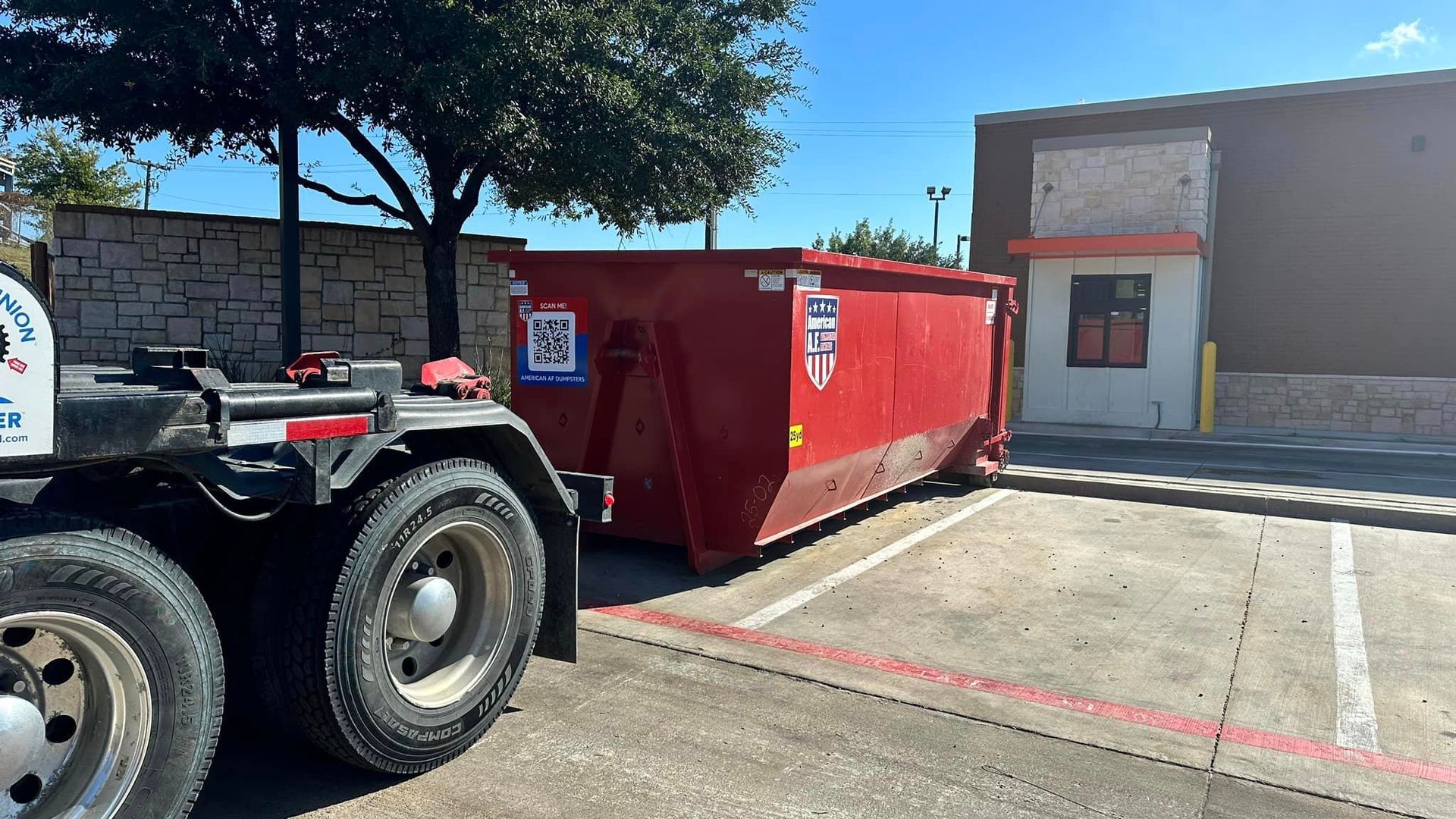
NEED A DUMPSTER?
What You CAN’T Throw Away
Refrigerators and Air Conditioners
These often contain freon and other hazardous substances, making them prohibited items in most dumpster rentals.
Refrigerators and air conditioners require specialized disposal due to their environmental impact. Freon, a refrigerant, can harm the ozone layer if not handled properly.
Tires
Old tires can become safety hazards and emit methane gas in landfills, making them a commonly prohibited item.
Tires are not biodegradable and can take up significant space in landfills. Their disposal is regulated to prevent environmental harm and optimize landfill space.
Paint and Lacquers
Leftover paint, lacquers, and wood stains are often hazardous and require proper disposal through a local recycler.
These products contain chemicals that can leach into the ground, contaminating soil and water. Specialized recycling prevents environmental contamination.
Adhesives
These contain flammable and toxic materials and are not suitable for general waste disposal.
Adhesives can release harmful chemicals when not disposed of properly. Special handling prevents potential health and environmental risks.
Non-alkaline Batteries
Lithium and car batteries are hazardous and should be taken to specific recycling centers or auto parts stores.
These batteries contain heavy metals and chemicals that are harmful to the environment. Recycling centers ensure safe processing and recovery of valuable materials.
Hazardous Materials
Items like paint thinners, propane tanks, and medical waste are hazardous and require special disposal methods.
Hazardous materials pose significant risks to public health and the environment. Special disposal methods ensure these materials are handled safely.
Medical Infectious Waste
This type of waste poses serious health risks and should be disposed of through specialized medical waste disposal services.
Medical waste can contain infectious agents and requires careful handling to prevent the spread of diseases. Specialized disposal services ensure safe and compliant handling of this waste.
Hot Water Tanks
These may contain hazardous substances, especially from older homes, and are not allowed in standard dumpsters.
Old hot water tanks might have insulation or residues that are hazardous. Proper disposal ensures these materials don't contaminate the environment.
Inks and Resins
These materials contain chemicals that can be harmful and should be handled by a hazardous waste disposal service.
Inks and resins often contain volatile organic compounds (VOCs) and other toxic substances. Specialized disposal prevents these chemicals from harming the environment.
Oils and Fuels
Automotive fluids and motor oil are hazardous and often have bounty programs for recycling at auto parts stores.
These fluids can contaminate soil and water if not disposed of properly. Recycling programs ensure they are processed in an environmentally friendly way.
Asbestos
Found in some older homes, asbestos requires special handling and disposal by certified professionals.
Asbestos is a known carcinogen and poses serious health risks. Professional disposal ensures safe removal and prevents exposure.
Household Cleaning Fluids
These fluids, including various household cleaners, are often toxic and not allowed in dumpsters.
Cleaning fluids can contain a range of harmful chemicals. Proper disposal is essential to prevent these chemicals from contaminating the environment.
Car Batteries
Old car batteries contain hazardous materials and are typically recycled through specialized programs.
Car batteries have components like lead and acid that require careful handling. Recycling programs ensure these materials are safely reclaimed.
Contaminated Soils & Absorbents
Soils contaminated with hazardous substances like oil-based paints or chemicals are not suitable for dumpster disposal.
Contaminated soils can pose significant environmental risks. Specialized disposal prevents the spread of contaminants.
Railroad Ties
Treated with chemicals, railroad ties pose environmental risks and are usually prohibited.
Railroad ties are often treated with creosote or other chemicals that can leach into the ground. Disposing of them in a controlled environment prevents environmental damage.
Industrial Drums
Containers that hold or held hazardous substances are not allowed due to potential contamination risks.
Industrial drums may have residues of hazardous chemicals. Proper disposal ensures these chemicals do not harm the environment.
For more information on what you cannot dispose of in a rented dumpster we suggest reading the prohibited items here ‘What Can't You Put in a Dumpster?’ by Dumpsters.com.
What You Can SOMETIMES Throw Away
Stumps
While small quantities of yard waste are accepted, large stumps may incur additional charges due to their size and weight.
Large stumps require more effort and space to handle, leading to additional charges. Small stumps, on the other hand, are easily processed with regular yard waste.
Mattresses and Box Springs
These items are sometimes allowed, but check with your dumpster rental company as they may require special handling or incur an extra fee.
Mattresses and box springs can be bulky and difficult to process. Some companies may accept them with an extra fee to cover the additional handling required.
Upholstered Furniture
Certain types of furniture, like sofas, might be allowed, but it’s a good idea to verify with the dumpster rental provider.
Upholstered furniture can vary in materials and treatment, some of which may be prohibited. Checking ensures compliance with disposal regulations.
Event/Food Waste
Food waste from events can usually be disposed of in dumpsters, but in large quantities, it might require a special roll-off container.
While small quantities of food waste are manageable, large volumes from events can create odors and attract pests, necessitating special containers.
Tree Stumps & Large Yard Debris
Similar to other yard waste, large tree stumps might be acceptable, but always check for any additional fees.
Large yard debris like tree stumps may require more space and effort for disposal. Fees help cover the cost of processing these larger items.
Additional Considerations
Ready to Rent a Dumpster?
When you're set to rent a dumpster, several key factors should guide your decision to ensure you make the most appropriate choice for your specific needs. Firstly, assess the scope of your project to determine the optimal dumpster size; a size too small could lead to overfilling, while an overly large one may result in unnecessary expenses. Secondly, be aware of the weight limits associated with different dumpster sizes. Overloading can result in extra fees or even the inability to haul away the dumpster. Lastly, familiarize yourself with local regulations as these can vary significantly by location. Some areas may have restrictions on certain types of waste or require permits for dumpster placement, especially in public or restricted areas.
Assessing the Right Size and Type
- Evaluate the volume and type of waste your project will generate. For household cleanouts, smaller dumpsters might suffice, but for construction or demolition debris, larger roll-off dumpsters are typically required.
- Consider the space available for placing the dumpster. Ensure that the chosen size fits in your designated area without obstructing traffic or violating local guidelines.
Understanding Weight Limits and Restrictions
- Different materials have varying weights; for example, yard waste is much lighter than construction debris like concrete or bricks. Choose a dumpster that can accommodate the weight of your waste materials.
- Inquire about specific weight allowances and the cost implications of exceeding these limits. Some rental companies may charge on a per-ton basis for overages.
Navigating Local Regulations and Permits
- Local regulations may dictate what can or cannot be placed in dumpsters. Hazardous materials, electronics, and certain appliances often have specific disposal requirements.
- Some localities require permits for dumpsters placed on public property or in certain zones. Check with your local municipality or your dumpster rental provider for guidance.
To get the latest information on dumpster rental requirements, we suggest reading this great article, ‘Dumpster Permits 101’.
Please Keep in Mind
It's essential to have a clear understanding with your waste management provider regarding the specific items you intend to dispose of. Direct communication helps in ensuring compliance with both the company’s policies and local regulations, thereby avoiding potential fines or service disruptions.
Confirming Acceptable Materials
- Different dumpster rental companies may have varying policies regarding what can be included in their dumpsters. Confirming this in advance helps in avoiding the inconvenience of having prohibited items in your load.
- For unique or questionable items, like mattresses, tires, or electronics, explicitly ask your provider for guidance. They can offer alternative disposal solutions or additional services for such items.
Adhering to Local Regulations
- Local regulations often have detailed guidelines on waste disposal, including sorting, recycling mandates, and restrictions on certain types of waste.
- Staying informed about these regulations not only helps in avoiding fines but also contributes to environmentally responsible disposal practices.
Environmental Considerations
- Consider the environmental impact of your waste. Inquire about recycling options or environmentally friendly disposal methods. Many companies offer services to sort and recycle eligible materials.
- For projects generating a significant amount of waste, consider ways to minimize the environmental footprint, like donating usable materials or choosing a waste management provider with strong environmental policies.
Safety and Accessibility
- Ensure that the placement of the dumpster does not pose a safety hazard to passersby or obstruct access to your property.
- Discuss with your provider the best practices for loading the dumpster to maintain safety and prevent issues during pickup.
By taking these additional considerations into account, you can make a well-informed decision that aligns with your project requirements, budget, and environmental responsibilities, while ensuring a hassle-free and compliant waste disposal process.
FAQS
-
What is the most common dumpster rental?
The most common dumpster rental typically involves roll-off dumpsters, which are widely used for residential and commercial projects due to their versatility and ease of use.
-
How do you pack a dumpster?
To pack a dumpster effectively, start by filling it with flat items at the bottom, then layer heavier items on top, and fill any gaps with smaller debris to maximize space and prevent shifting during transport.
-
What happens to items in a dumpster?
Items in a dumpster are usually taken to a waste management facility where they are sorted; recyclables are separated for processing, and the remaining waste is disposed of, often in a landfill or through incineration.
-
How do I get the most out of my dumpster?
To get the most out of your dumpster, efficiently pack it to maximize space, avoid prohibited items, choose the right size for your needs, and follow local regulations to prevent additional fees or complications.
-
What happens if you overload a dumpster?
If you overload a dumpster, you may face additional fees, and the dumpster rental company might refuse to haul it away due to safety concerns and legal weight limits, requiring you to remove excess material.

Powered by MagnateProSEO
All Rights Reserved | American AF Dumpsters

